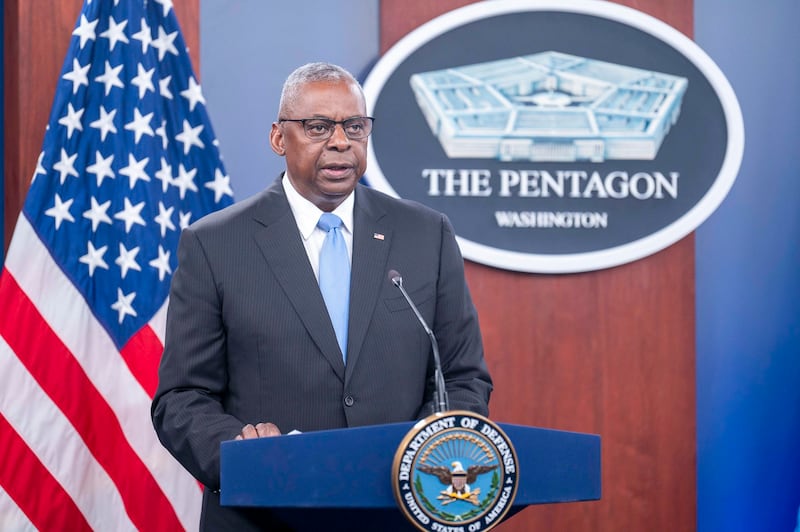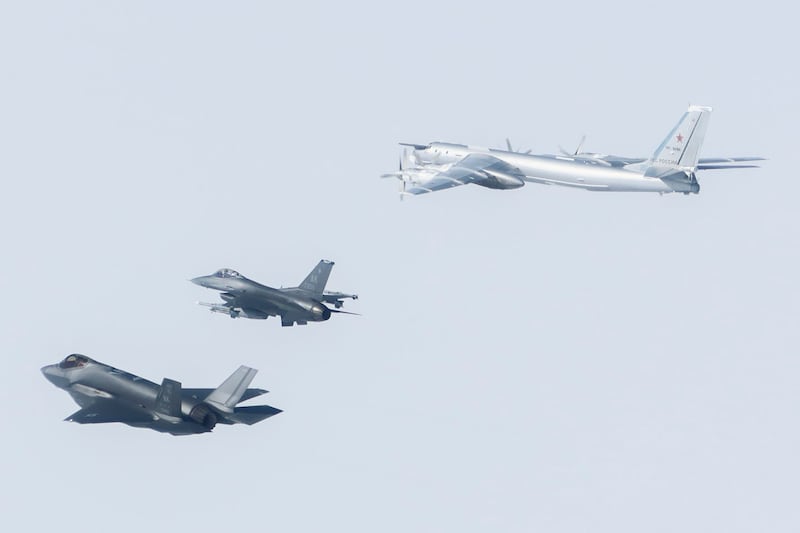The North American Aerospace Defense Command on Wednesday “detected, tracked, and intercepted” two Chinese and two Russian military aircraft operating together in international airspace off the coast of Alaska, but said the activity was “not seen as a threat.”
A Chinese defense official said Thursday that the planes were operating over the Bering Sea as part of a planned joint exercise and had “nothing to do” with recent tensions between Washington, Beijing and Moscow over cooperation between the latter two nations.
NORAD, a bi-national military command between the United States and Canada, said two Russian TU-95 bombers and two Chinese H-6 bombers were detected in the Alaska Air Defense Identification Zone, which is international airspace abutting U.S. and Canadian territory.
“An ADIZ begins where sovereign airspace ends and is a defined stretch of international airspace that requires the ready identification of all aircraft in the interest of national security,” NORAD said, adding that U.S. and Canadian forces had been “ready” to respond if needed.
“NORAD employs a layered defense network of satellites, ground-based and airborne radars and fighter aircraft in seamless interoperability to detect and track aircraft,” it said.
U.S. Defense Secretary Lloyd Austin said the joint operation by Chinese and Russian aircraft near America was unprecedented.

“This is the first time that we’ve seen these two countries fly together like that,” Austin said at a Pentagon press conference on Thursday. “They’re always testing us, and that’s no surprise to any of us.”
Russia's Defense Ministry released images of the Russian and Chinese jets flying over the Bering Sea, as well as the Chukchi sea to the north, and said in a statement that the four jets had at times been "accompanied" at times by fighter jets from "foreign" forces.
In Beijing, Chinese Defense Ministry spokesman Zhang Xiaogang said that the aircraft were operating over the Bering Sea as part of a “joint strategic aerial patrol” intended to “enhance” their ability to cooperate and was not meant to send any message.
“This action is not aimed at third parties,” Zhang said. “It is in line with relevant international laws and international practices, and has nothing to do with the current international and regional situation.”
‘Freedom of navigation’
The intercept of the aircraft is not the first time Chinese military forces have been detected near U.S. and Canadian territory.
Chinese naval ships have in the past month been detected operating within the U.S. Exclusive Economic Zone but in international waters near Alaska's Aleutian Islands, telling U.S. Coast Guard ships via radio that they were conducting "freedom of navigation" operations.
The explanation for their presence was an allusion to the U.S. military's frequent " freedom of navigation" tours of portions of the South China Sea, which are meant to counter China's extensive sovereign claims to the international waters but which have continuously irked Beijing.

After that incident, Sen. Dan Sullivan, a Republican from Alaska, said he believed it was only the beginning of what would be an increased Chinese military and naval presence around American territory.
"Our military needs to be ready for increasing Chinese, and joint Chinese and Russian military activity near Alaska's coast," Sullivan said in a post to X. "America must be much more prepared for the increasing activity in the Arctic, and to also let Alaskans know that our military is on the job protecting our state and our country."
Russia has also stepped up its military presence near U.S. territory, recently conducting military exercises with Cuba, which lies about 90 miles (145 kms) south of Florida. A report earlier this month said China, too, has built its own intelligence gathering operation in Cuba.
The report, issued by the Center for Strategic and International Studies on July 1, said the spy station would allow Beijing to monitor air and maritime traffic up to 9,000 miles (14,500 kms) away, prompting security concerns from U.S. defense officials and diplomats.
But Beijing has denied claims that it’s trying to target the continental United States, with Liu Pengyu, a spokesman for the Chinese Embassy in Washington, denying that such a spy station even exists.
"Such claims are nothing but slander," Liu wrote, also in a post to X. "The US side should immediately stop its smearing of China."
Chilly reception
The joint Chinese-Russian drills near Alaska also come as Washington, Beijing and Moscow compete for geopolitical dominance in the Arctic region, as Beijing eyes a greater presence there.
The Pentagon this week released its updated Arctic strategy. It cautioned that Beijing and Moscow's plans to extend their presence in the region "can hold U.S. and allied territories at risk," and calling for a greater U.S. military focus on operating in the Arctic region.
“The People’s Republic of China, not an Arctic nation, is increasing its presence in the Arctic,” it said in a statement, noting Beijing already has a military presence, including three icebreakers, in the Arctic and was pushing to have a greater role in how the region is governed.
“The Chinese military has also demonstrated its ability to operate in the Arctic by conducting operations with the Russian navy,” it said.
In a press briefing on Tuesday, Chinese Foreign Ministry spokeswoman Mao Ning called China an “important stakeholder” in the Arctic that “always follows the basic principle of respect” there.
“The U.S. misrepresented China’s Arctic policy and pointed fingers at China’s normal activities in the Arctic conducted in full compliance with international law,” Mao said at the briefing. “This is not conducive to peace, stability and cooperation in the Arctic.”
But the military element has been acknowledged in Moscow.
In an article about tensions over the Arctic, Russian state media quoted Ekaterina Labetskaya, an international relations researcher at the Russian Academy of Sciences in Moscow, as saying that Finland and Sweden's accession to NATO this year had changed calculations.
“The Arctic has long become a northern frontline of a global hybrid war, waged by the collective West led by the U.S. against Russia and its friendly countries with interests in that region,” Labetskaya said.
“The Arctic is being viewed from a new angle by both Russia and China,” she added, arguing that “all Arctic nations are reconsidering their military doctrines” in the wake of shifting global alliances.
